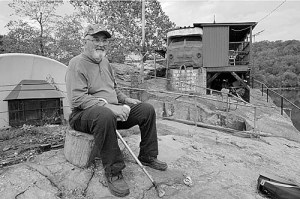

The bus belongs to Walter A. “Bruiser” Cole. The story goes that he bought the bus for $1.00 in 1954. Soon after the purchase, he plopped it on a rock in the middle of the river and built a fishing camp around it. The most comprehensive story I found about Bruiser was from somewhere around 2005. I read that Cole added electric service (hence the Christmas lights) and water service—water supply, of course, so the outhouse wasn’t put out of business during the occupation of the rock outcropping. Depending on which version of the history you read, he ether took the bus out on ice (unlikely due to the physics of moving water) or used a ferry boat to get the bus out in the river, and come-alongs and cables to haul it onto the rocks. Cole mentioned the ferry in an interview, so

I’m choosing to believe him. It is said he wished to have a peaceful spot from which to fish. It’s obvious he liked his creature comforts. All manner of chairs can be seen on the front porch, as can a washer\dryer combo. Neatness counts! The last article I found about him was published a few years before his passing. By that time he had stopped going to the camp, but kept an eye on it from his house in Gauley Bridge. Neighbors commented that the front of his house looked like a “permanent yard sale” and the man himself was cagey about revealing his past to an outsider. He admitted to working in coal and driving a school bus. There surely were a few other jobs in between. With a handle like “Bruiser,” there certainly is more to the story, but that belongs to those who knew him better.

It has been said that “possession is 9/10 of the law” and after Cole claimed his spot in the river, he stayed there, eventually getting a deed. In his later years he quit going out to the fishing camp and the place was given over to vandalism. Still, someone keeps it up. The fish camp survived a river cleanup project in the 70s, and despite rumors of it burning down, it’s still standing proud in the river. The edges of the camp are a little raggedy, but the place had obviously been cared for in some way; the paint appeared to be fairly fresh and the bus and porch were intact. Plastic chairs on the porch seemed to be waiting for someone to visit. Yankees that we are, we respected the many “no trespassing” and “keep out” signs posted at strategic points around the property.

I am drawn to people who do things out of sheer imagination, who are unfettered by the worries of fitting in or acting in such a way so the neighbors approve. What makes one man see a bus as a worthless broken down hunk of metal, and another sees the same bus as a potential castle? One man sees a pile of rocks in the river and decides it will be a personal island, and another man sees them as a place to put a monument to belief? Two miners, steeped in the tradition of one of the most dangerous jobs in our country, crawling into the bowels of the earth to retrieve fuel for people living lives they could only imagine. Perhaps it’s that imagination that drives such people to create improbable monuments to what is important to them. I wonder if Cole sat in his fish camp and watched Coffindaffer set his crosses on the neighboring stone, and whether they exchanged words in a fashion. Bernie and Bruiser. Wonder if they liked each other. Regardless, they each left their mark in the river, a few hundred yards apart.

Great story, loved it.
LikeLike